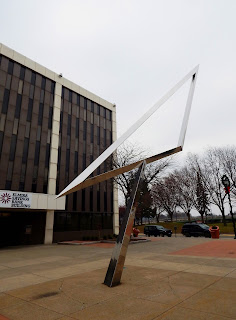Today marks the winter solstice: the shortest day and longest night of the year. There will only be about 9 hours of daylight today but from this point on, days will be getting longer. Yay! People may not know that we have a tool right here in Elmira to help us mark this auspicious day. Anyone who has visited the Elmira Savings Bank at 333 E. Water Street, has probably seen the large, triangular metal sculpture in the plaza outside. For a long time, I assumed it was just a big piece of art and gave it no more thought. It actually was created to mark the solstices and equinoxes.
 |
| The Sun Triangle |
The Sun Triangle, as it is called, was erected in March 1977
by the Arnot Realty Corporation. It was created as part of Elmira’s city
beautification program following the 1972 flood that devastated much of
downtown. The triangle was designed by scientist and sculptor Dr. Athelstan
Spilhaus of Washington, D.C. and built by metal fabricators in Brooklyn, New
York. The skin is made of 1/8 inch stainless steel that has been polished to a
mirror finish.
 |
| View of the Sun Triangle from Water Street |
 |
Diagram from the Elmira Savings Bank’s
booklet about the Sun Triangle.
|
So, how does it work? The top edge of the triangle points to the sun’s noon position at the spring and fall equinoxes, about March 21 and September 22. The bottom edge points to the sun’s lowest noon position, at the winter solstice, about December 21. And the steepest edge points to the sun’s highest noon position, at the summer solstice, about June 21. Conveniently, there’s a plaque on the ground right next to the Sun Triangle explaining all this.
 |
| Plaque near the base of the Sun Triangle |
This year, the solstice officially falls on December 21 at 11:49pm (EST). Unfortunately, it looks like it may be too cloudy today to actually see the sun at local noon. It might be worth the short walk from the museum to take a look, though. Happy Winter Solstice!

Great! Here's to longer days!
ReplyDeleteHow awesome to have this sun triangle right in Elmira's downtown!
ReplyDeleteThat is wicked cool! Now we can set a destination for Spring! to check it out and all the other awesome things in Elmira.
ReplyDelete